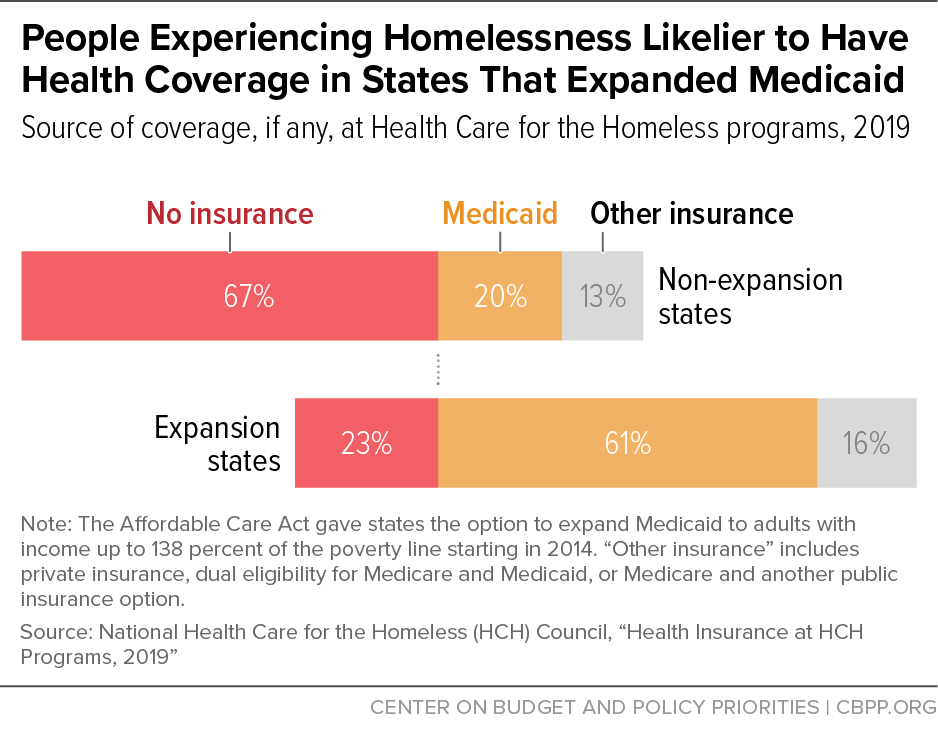BEYOND THE NUMBERS
Deeper Investments in Housing and Health Can Advance Housing Justice, Health Equity
As we lay out in a new chart book, deeper investments in health coverage and affordable housing, together, can be a powerful way to advance health equity.
Federal and state policymakers have several tools at their immediate disposal to better integrate health and housing services. Congress should act now to close the Medicaid coverage gap as part of economic reconciliation legislation being negotiated this summer, an action that wouldn’t foreclose the 12 holdout states from expanding Medicaid to take full advantage of existing financial incentives to do so.
Also, states should use Medicaid’s flexibilities to increase access to housing-related supports for people at risk of housing instability or homelessness, and Congress should pass an annual appropriations package that funds a significant number of new Housing Choice Vouchers.
Housing is an integral driver of health. It can expose someone to health-enhancing community assets like green space, public transit, grocery stores, and health care providers, and to harmful things like environmental toxins and crime. And for unhoused people, living in crowded shelters or on the street can take a toll on their health and mental well-being.
A history of discriminatory housing practices and the rising cost of housing contribute to homelessness and often limit housing choices for people with low incomes. As a result, low-income people, disproportionately people of color, are more likely to live in communities facing systematic underinvestment where access to quality health care and services is limited. This lack of investment worsens health disparities for people with low incomes.
Federal rental assistance programs such as Housing Choice Vouchers reduce crowded housing and homelessness, and are associated with lower rates of food insecurity, intimate partner violence, and alcohol dependence or drug use, research shows. But they are severely underfunded, serving just 1 in 4 qualifying families. As a result of this funding gap, low-income renters and renters of color are disproportionately likely to be housing cost burdened — that is, to spend more than 30 percent of their income on rent. Black and Latino renters are the most likely to be housing cost burdened, and white renters the least likely.
High housing costs can force people with low incomes to choose between paying rent and getting needed medical care. People who are worried about paying their rent or mortgage are more likely to postpone getting care due to cost, to not have a usual source of care, and to skip an annual check-up.
Advancing health equity and reducing racial and ethnic disparities in poverty and housing access require deeper investments in health care and housing vouchers for people with low incomes, combined with stronger partnerships between the health and housing sectors. These connections include supports to help people leaving homelessness, jails, prisons, and nursing homes find and maintain affordable housing and health services. And they’re particularly important for people with mental health issues, substance use disorders, and people with disabilities. Stable access to housing and needed health services allows more people to live in the community and can reduce their health care costs.
Federal and state policymakers can better integrate health and housing services by taking the following steps:
- The 12 states that have not yet done so should expand Medicaid, which among its many benefits would reduce both uninsured rates among people experiencing homelessness (see chart) and evictions.
- States should use Medicaid flexibilities to increase access to housing for people at risk of housing instability or homelessness. States can cover pre-tenancy and tenancy-sustaining services through Medicaid. They can also use the American Rescue Plan’s additional funding for Medicaid home- and community-based services (HCBS) to support housing-related initiatives like developing accessible and affordable housing units, providing housing-related services and supports, and creating new cross-agency partnerships. Twenty-one states already use this HCBS funding for housing-related initiatives, but more states could. States have until March 31, 2025, to spend it.
- Congress should pass an annual appropriations package that includes a significant number of new Housing Choice Vouchers. The House Appropriations Committee’s proposal to add 140,000 vouchers could help an estimated 302,000 people, including 96,000 children, 53,000 people with disabilities, and 37,000 older adults. Nearly two-thirds of the new vouchers would go to households of color due to their disproportionate rates of need.

